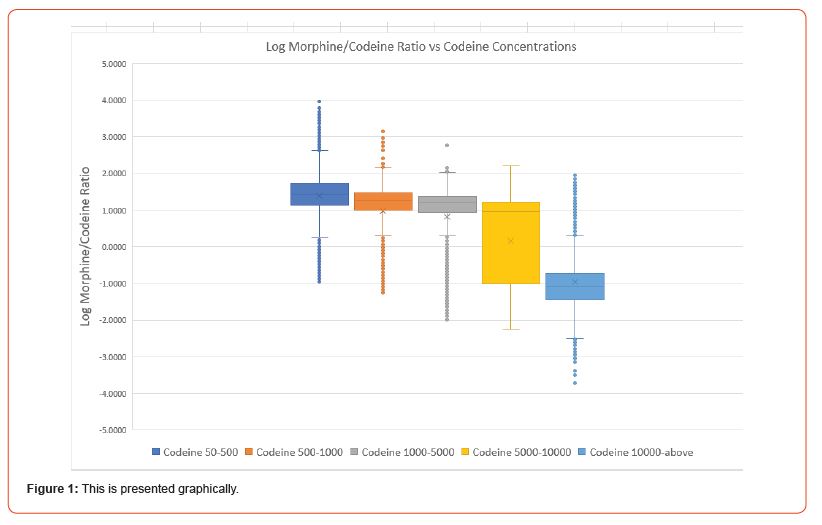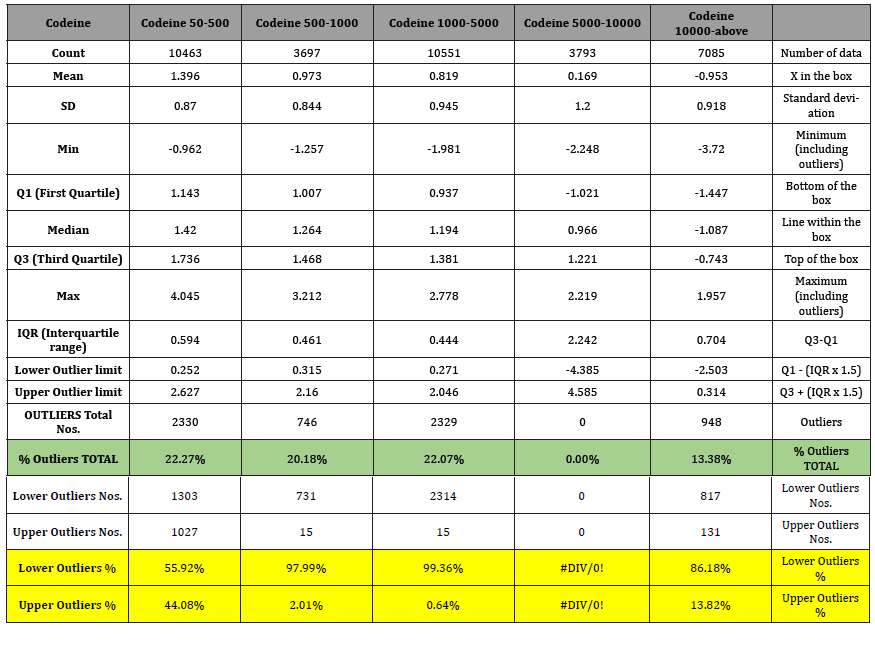 Research Article
Research Article
Incidence of Morphine in Codeine Positive Urine Drug Tests
Agnes Cua, Kevin Krock, Richard Thomas, and Amadeo J Pesce*
Precision Diagnostics LLC, San Diego, CA, USA
Amadeo J Pesce, Professor, Precision Diagnostics LLC, 4215, Sorrento Valley Boulevard, San Diego, CA 92121, United States.
Received Date: August 24, 2023; Published Date: September 01, 2023
Abstract
Urine drug tests monitor both codeine and morphine. It is expected that the presence of codeine should be accompanied by morphine. We observed about 6.14% of our positive codeine results were negative for morphine. At concentrations of codeine greater than 10,000ng/mL, we observed low concentrations of morphine consisted with attempted deception.
Keywords:Codeine; Morphine; Urine drug tests; CYP2D6
Background
Codeine is produced by the poppy seed plant. Once ingested by patients some of the codeine is metabolized to morphine and both the codeine and morphine can be detected in urine. It is argued that the codeine analgesic effect is due to this conversion to morphine by the CYP2D6 enzyme [1]. There has been one recent report finding cases of codeine without morphine in positive urine drug tests [2]. We wished to determine if the presence of codeine and not morphine was a common occurrence.
Methods
Our test population was from pain and rehabilitation clinics as previously described [3]. We examined 35,589 urine drug tests positive for codeine between Jan 1, 2020, and May 2023. The test method was that of Krock et al. [4]. The data analysis was previously described [5]. We segregated the data by the amount of codeine observed. These data sets were Codeine 50-500ng/ mL, Codeine 500-1000ng/mL, Codeine 1000-5000ng/mL, Codeine 5000-10000ng/mL and Codeine above 10000ng/mL. (Table 1)
Results
We observed that in 10,000 patient samples positive for codeine, about 6.14% were negative for morphine. For those that were positive for both morphine and codeine, at the lowest concentration bracket the median ratio of morphine to codeine was 26 to 1, this declined as the concentration of codeine increased which is visually depicted in the Box plot (Figure 1). At the lowest concentrations of codeine, we observed much more morphine than codeine (median log ratio 1.420). This ratio decreased as the concentration of codeine increased to 1.264 at 500-1000ng/ mL; 1.194 at 1000-5,000ng/mL; 0.966 at 5,000-10,000ng/mL and -1.087at concentrations greater than 10,000ng/mL. However, at concentrations of codeine greater than 10,000ng/mL, there was a breakdown in this ratio. Codeine was observed to be much grater than that of morphine.

Table 1:Summary data for urine specimens positive for morphine and codeine.

Discussion
The lack of conversion of codeine to morphine is not unexpected. The expected failure to transform codeine to morphine based on CYP2D6 polymorphisms is about 7% (based on our previous work) [6]. In this study we observed it to be 6.14%. Our observations are consistent with those of Reisfeld et al [2]. As noted in our previous work, the high concentrations of codeine with little or no morphine were consistent with attempts at deception leading to a greater portion of the specimens having low metabolite to parent drug ratios [7]. Our conclusion is that the presence of codeine in urine drug tests will not always have morphine as a companion drug.
Acknowledgement
All the authors are employees of Precision Diagnostics LLC.
Conflict of Interest
There are no conflicts of interest.
References
- (2023) Codeine. Wikipedia.
- Reisfield GM, Teitelbaum SA, Joseph T, Jones JT (2023) Poppy Seed Consumption May Be Associated with Codeine-Only Urine Drug Test Results. J Anal Toxicol 47(2): 107-113.
- Pesce A, Sundyhanata R, Ritz D, Richard R, Ackerman G, et al. (2021) Effects of a Pandemic and Isolation on Alcohol and Psychoactive Medication Use in a Population of Rehabilitation and Pain Patients. Ann Clin Lab Sci 51(5): 694-697.
- Krock K, Pesce A, Ritz D, Thomas R, Cua A, et al. (2017) Lower Cutoff for LC-MS/MS Urine Drug Testing Indicates Better Patient Compliance. Pain Physician 20: E1107-E1113.
- Pesce AJ, Chandler N, Ackerman G (2021) Information Technology Structure for Urine Drug Testing Reports. 21st Century Pathol 1(1): 103.
- Bevins NJ, Jensen KJ, Horn PS, Pesce AJ (2022) Phenotypic Identification of Patients with Abnormal CYP2D6 or CYP3A4/5 Metabolism from Routine Oxycodone Monitoring. 21st Century Pathology 2(4): 126.
- Cua A, Krock K, Thomas R, Pesce AJ (2023) Observations of Deception in Urine Drug Testing. Ann Clin Lab Sci 53(4): 671-672.
-
Agnes Cua, Kevin Krock, Richard Thomas, and Amadeo J Pesce*. Incidence of Morphine in Codeine Positive Urine Drug Tests. Open Access J Addict & Psychol 7(4): 2023. OAJAP.MS.ID.000668.
Amphetamine; Methamphetamine; Urine; Oral fluid; Metabolic ratio; Oral Fluid; Metabolic concentrations; Urine concentrations; Parent drug; Drug use; Basic fluids
-

This work is licensed under a Creative Commons Attribution-NonCommercial 4.0 International License.






